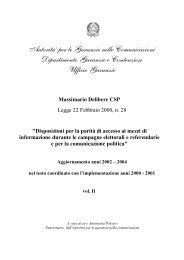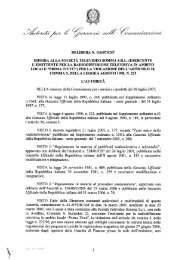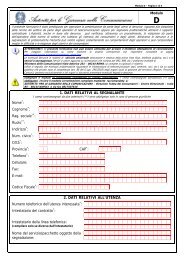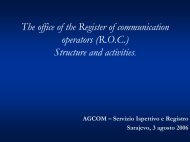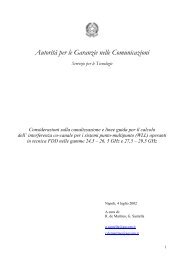Communications Regulatory Authority
Communications Regulatory Authority
Communications Regulatory Authority
Create successful ePaper yourself
Turn your PDF publications into a flip-book with our unique Google optimized e-Paper software.
Nelonen, Nokia, TeliaSonera, and YLE) and 500 users of the city of Helsinki. Digita<br />
won the first license assigned b the Ministry of Transportation and <strong>Communications</strong> for<br />
the commercial launch of mobile television services using the DVB-H standard.<br />
In Spain, two experiments (also conducted on the DVB-H technology) have<br />
been concluded; they concerned the areas of Madrid, Barcelona, and Seville, and<br />
involved numerous communication companies (Abertis Telecom, Nokia, Telefónica<br />
Móviles, Antena 3, Sogecable, Tele 5, RTVE, Telemadrid, TV de Catalunya, Vodafone<br />
España, Net TV, RTVA, RTVV, and Veo TV).<br />
In the United Kingdom, O2, Arqiva, Nokia, BBC, ITV, Channel 4, Five TV,<br />
Turner Broadcasting, Shorts International, Discovery, Eurosport, MTV, and BSkyB<br />
started an experiment in Oxford whose final results will be announced in 2006.<br />
In France, the Higher Council of the Audiovisual authorized four experiments in<br />
the Paris area: three of the four authorized consortiums will use the DVB-H standard,<br />
while one will use the Korean Terrestrial Digital Multimedia Broadcasting (T-DMB)<br />
standard.<br />
Lastly, television and radio service experiments based on the DVB-H standard<br />
are under way in Holland, with the involvement of the operators KPN, Digitenne,<br />
Nozema Services, and TNO.<br />
Another technology, which has recently been tested for the supply of television<br />
services to mobile users, is the Digital Audio Broadcasting Internet Protocol (DAB-IP).<br />
In 2005 British Telecom and Virgin Mobile tried this standard on around 1,000 users, to<br />
whom a packet of television and radio channels was proposed.<br />
Qualcomm and the satellite pay-TV operator BSkyB have signed a letter of<br />
intent for the carrying out, in Great Britain, of experiments on the MediaFLO<br />
technology, which is used, as we have already seen, in the United States. The start-up is<br />
planned for the summer of this year, and will involve a selection of BSkyB channels<br />
that will be made available on several terminals provided by Qualcomm.<br />
Also from the standpoint of the supply of value-added services on mobile<br />
terminals, portals have been the main instrument through which operators have carried<br />
such services. Thanks to the portal, the mobile operator does not limit itself simply to<br />
providing the infrastructure through which the content arrives to the end users, but it<br />
creates actual environments in which the user finds a rich selection of quality<br />
audiovisual contents and services which are optimized for reception on the terminal.<br />
Until now, most of the operators’ portals have fallen within the category of the<br />
so-called “walled gardens”, the term used to indicate the control exercised by the<br />
operator in the users’ enjoyment of the value-added mobile contents and services. The<br />
operators that use “walled garden” portals implement policies aiming to discourage the<br />
free enjoyment of content outside their own mobile portal, by applying, for example,<br />
higher rates for navigation on sires not included in their portal, or by making it<br />
complicated for users to reach other sites outside of it.<br />
27




